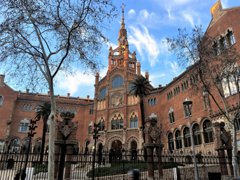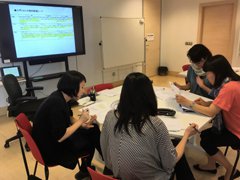The Work of the Japanese-Language Specialist - Building a Transnational Network
The Japan Foundation, Madrid
MATSUSHITA Keiko
I was dispatched as the Japanese-Language Specialist (hereinafter “Specialist”) in charge of the Japanese-language course here in July 2016, and soon I will complete my two-year term of dispatch and return to Japan. I introduced the management of the Japanese-language course at the Japan Foundation, Madrid (hereinafter “JFMD”) in my report for AY2017, so in this report I would like to reflect back on my job as the Japanese-Language Specialist in charge of the Japanese-language course for the past two years.
Recruiting Support to Improve the Japanese-Language Course
JFMD offers the “Marugoto: Japanese-Language and Culture” Japanese-language course generally geared towards working adults. There are also collaborating schools, called Casa Asia, located in Madrid and Barcelona which operate using the same curriculum as the JFMD courses, and there are a total of six part-time teachers running the courses, including those at the collaborating schools. My work as the Specialist in charge of the Japanese-language courses is diverse, but the hardest parts of the job are revising the final exam and evaluation planning. The final exams which previous Specialists at JFMD had created required to be steadily revised based on the reactions of students and comments from the teachers, while a new test had to be created for the intermediate course from scratch, so I had to consider what a “Marugoto style” test would be, and tried many methods to create it through trial and error.

Casa Asia Barcelona, located in the Hospital de la Santa Creu i Sant Pau, a World Heritage site.
Regarding how to evaluate the tests, we held a “Japanese-Language Course Meeting” once per year to which the Specialists in charge of the Japanese-language course in Europe gathered (including Paris, Rome, Cologne, and Madrid). In addition to discussions on how to evaluate the tests, we also exchanged information on the Japanese-language course at each office and share opinions with each other. The issue I wanted to focus on was how to provide feedback that would be of benefit to the learners, and I revised the written test accordingly after the meeting in my first year. Specifically, I changed the written portion of the test from an essay question to a pre-assignment, and switch the evaluation thereof to the rubric approach, and created a sheet that allowed comparing the self-evaluation to the teacher’s evaluation. As a result, the learners produce texts with more effort going into them, and the results can be saved as a portfolio which serves as feedback for the learner, and the teachers in charge offered comments that this was a good change.
During the second year’s meeting, we considered qualitative evaluation criteria for the verbal test. The structure of European verbal test evaluation sheets is divided into task achievement level and qualitative aspects, so at the meeting, we established the qualitative criteria for the A2 completion level while referring to the CEFR and the JF Standard for Japanese-Language Education. We then brought these back to each of our dispatched offices to revise the evaluation sheets we used in the Japanese-language course. At JFMD, we had the teachers decide what to write on the rubric evaluation sheet during the intra-institutional teacher training, and we intend to use that evaluation sheet starting with the next test.
A single Specialist would be unable to reform the Japanese-language course on their own. While this may be obvious, my assignment here has taught me once again that it is important to work with the teachers in the organization and Specialists from other regions in order to improve the course.
Our Involvement with Japanese Teachers in Spain and Portugal

Intra-institutional teacher training
(Creating a rubric evaluation for a verbal test)
While most of my work involves Japanese-language course management, I also engaged in other tasks during the second year, such as teacher training for outside Japanese teachers, and preparing the “Marugoto Intermediate 2 Grammar Manual” as a collaborative project with the Association of Teachers of Japanese in Spain (APJE). The former was my first time to carry out teacher training, so it took me some effort at first to decide how to plan content that met the needs of the requesting organization, but my senior Specialists offered advice that was very helpful to me. I felt that the key point to holding the teacher training was to base it on my own experience, without trying to overextend myself, and then to proceed with the training from the same perspective as the participating teachers.
I worked with the Japanese teachers of APJE for six months to write the grammar manual while having the members of the Research and Development Section, who created “Marugoto Intermediate 2,” review the copy and provide advice. We are now in the final stages of editing, and intend to publish the completed document on our website when finished.
Education in Practice and Network Building
As part of our Japanese-language courses, I am in charge of the intermediate class using “Marugoto Intermediate 2,” in which I have tried many classroom approaches. I made a point to go beyond the activities contained in the text, such as emphasizing communication during writing activities by adopting a role play or free talk approach, or holding three-minute presentations as a part of project work. Currently I hold courses for specific purposes at the intermediate to advanced level. The challenge in those cases is how to create something appropriate to Marugoto without using “Marugoto.”
I also held a cultural experience course titled “Voice Actor Workshop” for the course students. The workshop concept is to “speak Japanese in your own way” with reference to the “stereotypical speech” concept. Participants use the Japanese they know to come up with their own script and then pretend to be a character in a Japanese film for post-synchronization. The workshop has proven to be extremely popular and well received by the students because anyone from starter to intermediate level can join without worry. The workshop will next be held at Casa Asia Barcelona in June.
In the future I intend to introduce these activities to research groups and academic conferences and exchange ideas with other Japanese teachers working in a variety of classrooms. Finally, looking back on the past two years of activities, I see that the Japanese-language courses were managed only with the help of numerous people, allowing me to successfully complete my mission as a Specialist. I offer my sincere gratitude to everyone who supported me.
- What We Do Top
- Arts and Cultural Exchange [Culture]
- Japanese-Language Education Overseas [Language]
- Japanese-Language Education Overseas [Language] Top
- Learn Japanese-language
- Teach Japanese-language
- Take Japanese-Language Test
- Know about Japanese-language education abroad
- The Japanese-Language Institute, Urawa
- The Japanese-Language Institute, Kansai
- Japanese-Language Programs for Foreign Specified Skilled Worker Candidates
- Japanese Language Education for Japanese Children Resident Overseas and for the Descendants of Migrants
- Archives
- Japanese Studies and Global Partnerships [Dialogue]
- JF digital collection
- Other Programs / Programs to Commemorate Exchange Year
- Awards and Prizes
- Publications
